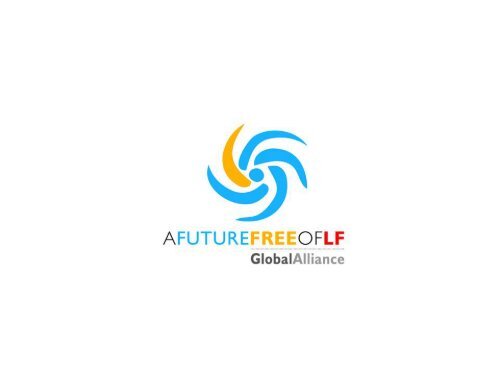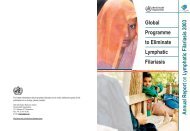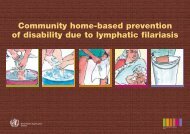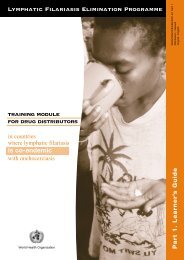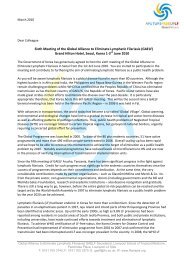Day Two - Afternoon - Global Alliance to Eliminate Lymphatic Filariasis
Day Two - Afternoon - Global Alliance to Eliminate Lymphatic Filariasis
Day Two - Afternoon - Global Alliance to Eliminate Lymphatic Filariasis
You also want an ePaper? Increase the reach of your titles
YUMPU automatically turns print PDFs into web optimized ePapers that Google loves.
Linking the programmes:<br />
New partnerships with<br />
onchocerciasis programmes<br />
GAELF 7<br />
World Bank<br />
Washing<strong>to</strong>n DC<br />
18-19 November 2012<br />
Adrian D Hopkins<br />
Mectizan Donation<br />
Program<br />
www.mectizan.org
• Common populations infected<br />
• Common disease agent<br />
• Common treatment<br />
• Common M&E<br />
• Common challenges
Common populations infected
Common populations<br />
In Africa and the Yemen
<strong>Lymphatic</strong> <strong>Filariasis</strong> Current<br />
Status
Onchocerciasis Treatment<br />
areas
Common Disease agent
Filaria<br />
• Both diseases are caused by filarial<br />
species !
Common treatment
Treatment<br />
• Both diseases use Mectizan in<br />
Onchocerciasis endemic areas<br />
• Albendazole is needed for LF and<br />
may well speed up onchocerciasis<br />
elimination
Common M&E
M & E commonalities<br />
• Both diseases need better diagnostics for<br />
M&E<br />
– Parasi<strong>to</strong>logical investigations. Night blood and<br />
skin snips ARE NOT POPULAR<br />
– Existing serological test are not ideal<br />
– Need for human and labora<strong>to</strong>ry capacity<br />
building <strong>to</strong> carry out en<strong>to</strong>mological and<br />
parasi<strong>to</strong>logical surveys<br />
– Existing methods of M&E are costly
Common challenges
at risk population (million)<br />
Common challenges 1<br />
Scaling up<br />
Treatment targets<br />
Treated (million)<br />
350.0<br />
Source: WHO/AFRO Neglected Tropical Diseases<br />
300.0<br />
250.0<br />
200.0<br />
81% LF<br />
Treatment<br />
150.0<br />
111.9<br />
100.0<br />
82.8<br />
69.3<br />
57.8<br />
46.6<br />
50.0<br />
28.0<br />
34.0<br />
16.5<br />
20.8<br />
9.4<br />
0.2 3.0<br />
-<br />
2000 2001 2002 2003 2004 2005 2006 2007 2008 2009 2010 2011 2012 2013 2014 2015 2016 2017 2018 2019 2020 2021<br />
Treatment targets 1.1 2.9 7.5 15.6 20.1 31.6 35.0 50.0 64.0 72.3 92.4 138.6 188.6 240.4 288.1 288.7 283.1 238.5 174.9 104.3 39.6 -<br />
Treated (million) 0.2 3.0 9.4 16.5 20.8 28.0 34.0 46.6 57.8 69.3 82.8 111.9
18 million people in areas where<br />
nodule prevalence is between 5<br />
and 15%
‘Big 4’ countries account for 60%, 9<br />
Countries account for 80% of people<br />
not covered by LF treatment
2.<br />
M<br />
a<br />
p<br />
p<br />
i<br />
n<br />
g
3.<br />
Cross<br />
border<br />
issues
Common challenges 4 Loa loa<br />
Zouré HGM, Wanji S, Noma M, Amazigo UV, Diggle PJ, et al. (2011) The Geographic Distribution of Loa loa in<br />
Africa: Results of Large-Scale Implementation of the Rapid Assessment Procedure for Loiasis (RAPLOA). PLoS<br />
Negl Trop Dis 5(6): e1210. doi:10.1371/journal.pntd.0001210
Where are the co-endemic<br />
areas? RAPLOA results<br />
PLoS Negl Trop Dis 5(6): e1210. doi:10.1371/journal.pntd.0001210
Population at risk
MEC TCC guidelines<br />
www.mectizan.org
Conclusions<br />
Co-implementation<br />
Opportunities for synergy (LF/oncho)<br />
• Integrated mapping<br />
• Joint implementation of training<br />
• Joint implementation of MDA (combined<br />
treatment registers, simultaneous drug<br />
administration<br />
• Joint Moni<strong>to</strong>ring and reporting<br />
• Joint epidemiological evaluations
Conclusions<br />
• I am not advocating for<br />
exploiting the synergies in<br />
two programmes<br />
• I advocate for one<br />
programme in Africa
GAELF-7<br />
Linking the Programmes<br />
Extending the Benefits<br />
David Addiss<br />
19 November, 2012<br />
Washing<strong>to</strong>n, DC
Extending the Benefits<br />
Not a new idea…
Extending the Benefits
Benefits Realized<br />
Soil-transmitted helminthiasis (STH)<br />
• 2 billion treatments with combination<br />
therapy using albendazole, 2001-2011 *<br />
• In 2010, 57% of school-age children<br />
treated for STH were treated through<br />
PELF<br />
• Community-based distribution<br />
* Courtesy of Dr. KD Ramaiah
Benefits realized<br />
• ‘Ancillary benefits’<br />
• Bold vision<br />
• Advanced NTD agenda<br />
• Platform for integrated<br />
NTD programs
Extending the Benefits<br />
Have the benefits been fully extended<br />
<strong>to</strong> those with LF-related disease?
“<strong>Two</strong> Pillars” of LF Elimination-<br />
Rationale
“<strong>Two</strong> Pillars” of LF Elimination-<br />
Rationale
“<strong>Two</strong> Pillars” of LF Elimination-<br />
Rationale
Morbidity Control & Disability<br />
Prevention
Components of NTD Control<br />
Preventive Chemotherapy<br />
Vec<strong>to</strong>r<br />
Control<br />
Water,<br />
Sanitation,<br />
Hygiene<br />
Clinical<br />
Care
<strong>Lymphatic</strong> <strong>Filariasis</strong> Elimination<br />
“<strong>Two</strong> Pillars”<br />
“Interrupt transmission”<br />
“Care for those<br />
with disease”<br />
Preventive Chemotherapy<br />
Morbidity<br />
Management<br />
& Disability<br />
Prevention<br />
Vec<strong>to</strong>r<br />
Control
Preventive Chemotherapy<br />
Dominant Organizing Principle for STH Control<br />
Preventive Chemotherapy<br />
Water,<br />
Sanitation,<br />
Hygiene
Elimination of Blinding Trachoma<br />
’SAFE’ Strategy<br />
Antibiotics<br />
Environmental<br />
Improvement<br />
Surgery<br />
Facial<br />
cleanliness
LF Elimination<br />
Internally and Externally Integrated<br />
Source: WHO
Legs <strong>to</strong> Stand On Framework<br />
Courtesy: Dr Mary Jo Geyer
Benefits realized<br />
• ‘Ancillary benefits’<br />
• Bold vision<br />
• Advanced NTD agenda<br />
• Platform for integrated NTD programs<br />
• “Seeing the faces”
“Willing <strong>to</strong> see faces”<br />
“If we are <strong>to</strong> maintain the reputation this<br />
institution now enjoys, it will be because in<br />
everything we do, behind everything we say,<br />
as the basis for every program decision we<br />
make—we will be willing <strong>to</strong> see faces.”<br />
Bill Foege, Smallpox, Gandhi, and CDC<br />
– Fifth Annual Joseph Mountain<br />
Lecture, Atlanta, Oc<strong>to</strong>ber 26, 1984
Elements of Compassion<br />
• Awareness of suffering (cognitive<br />
attunement)
Awareness of Suffering
Elements of Compassion<br />
• Empathy (emotional attunement)
Empathy<br />
The Power of Personal S<strong>to</strong>ry<br />
Courtesy:<br />
Fr. Thomas<br />
Streit
Elements of Compassion<br />
• Awareness of suffering (cognitive<br />
attunement)<br />
• Empathy (emotional attunement)<br />
• Action (<strong>to</strong> relieve suffering)
Compassion and Action<br />
• “[Compassion] is not just a wish <strong>to</strong> see sentient beings<br />
free from suffering, but an immediate need <strong>to</strong><br />
intervene and actively engage, <strong>to</strong> try <strong>to</strong> help.”<br />
• “A person who has attained stability in his or her<br />
compassion training … should now be out, running<br />
around like a mad dog, actively<br />
engaged in acts of compassion.”<br />
- His Holiness the Dalai Lama<br />
Source: Davidson RJ and Harring<strong>to</strong>n A, eds. Visions of<br />
Compassion: Western Scientists and Tibetan Buddhists Examine<br />
Human Nature. Oxford University Press, New York, 2002
Compassionate action
Certification of <strong>Lymphatic</strong> <strong>Filariasis</strong><br />
Elimination in China, 2008
Challenges <strong>to</strong> Compassion<br />
in LF Elimination<br />
• Empathy (emotional attunement)<br />
– Geographic distance<br />
– How <strong>to</strong> keep seeing the ‘faces behind<br />
the numbers’?<br />
– Compassion for<br />
populations
Challenges <strong>to</strong> Compassion<br />
in LF Elimination<br />
• Action (<strong>to</strong> relieve suffering)<br />
– Complex systems<br />
– Institutional agendas<br />
– Competing motivations
GPELF: “…a mass uprising of compassion”
Extending the Benefits<br />
The Challenge of Paradox<br />
• Maintain focus while expanding peripheral<br />
vision<br />
• A united LF program with activities across<br />
different sec<strong>to</strong>rs of the health system<br />
• See the faces and the numbers at the same<br />
time<br />
• Compassion for individuals and action at the<br />
population level
Thank you<br />
Pho<strong>to</strong>s courtesy of Fr. Thomas Streit and Dr Patrick Lammie
Insert teshome
<strong>Lymphatic</strong> <strong>Filariasis</strong><br />
Partnerships with Malaria<br />
Programs: Experience in<br />
Nigeria<br />
Frank Richards, Jr., MD<br />
Direc<strong>to</strong>r<br />
Malaria, <strong>Lymphatic</strong> <strong>Filariasis</strong>, River<br />
Blindness and Schis<strong>to</strong>somiasis Programs<br />
<strong>Global</strong> <strong>Alliance</strong> for the Elimination of<br />
<strong>Lymphatic</strong> <strong>Filariasis</strong><br />
19 November 2012
• WER 2011
Nigeria
Nigeria former Head of State General Dr. Yakubu Gowon
<strong>Lymphatic</strong> <strong>Filariasis</strong><br />
Elimination
Integrated Onchocerciasis, <strong>Lymphatic</strong><br />
<strong>Filariasis</strong> and Urinary Schis<strong>to</strong>somiasis<br />
Activities in Nigeria<br />
Published in 2002<br />
Funded by GSK
Published in 2002
Primary Vec<strong>to</strong>r in Nigeria:<br />
Anopheles gambiae
Malaria<br />
• Plasmodium destroys red<br />
blood cells<br />
• Fever….also Anemia<br />
• Mosqui<strong>to</strong> transmitted<br />
• ~1 million deaths each year<br />
(mostly children
Malaria<br />
Moni<strong>to</strong>ring and Evaluation<br />
Future Key Outcomes:<br />
- Malaria death/cases/<br />
prevalence/transmission<br />
- Anemia<br />
- LLIN ownership<br />
- LLIN usage
Impact of LLIN on LF Mosqui<strong>to</strong><br />
Infection
80,000 mosqui<strong>to</strong> dissections since 1998
INFECTIVE STAGE LARVA
Average Mosqui<strong>to</strong> LF Infection Rates (all larval stages) in 9<br />
Sentinel Villages (through (Baseline September through 2010) 2011)<br />
3.5%<br />
3.0%<br />
2.5%<br />
3.1%<br />
Mass drug administration<br />
2.0%<br />
1.5%<br />
1.0%<br />
0.5%<br />
0.0%<br />
1.1%<br />
0.8%<br />
0.5% 0.4% 0.4%<br />
0.4% 0.3%<br />
Baselne 2004 2005 2006 2007 2008 2009 2010<br />
Infected<br />
0.0%<br />
Based on >44,000 dissections
Average Mosqui<strong>to</strong> LF Infection Rates (all larval stages) in 9<br />
Sentinel Villages 2000 – September 2011<br />
3.5%<br />
3.0%<br />
2.5%<br />
3.1%<br />
Mass drug administration<br />
LLIN<br />
2.0%<br />
1.5%<br />
1.0%<br />
0.5%<br />
0.0%<br />
1.1%<br />
0.8%<br />
0.5% 0.4% 0.4%<br />
0.4% 0.3%<br />
Infected<br />
0.0%<br />
Baselne 2004 2005 2006 2007 2008 2009 2010 2011<br />
In 2011, for the first time, no infective (L3) mosqui<strong>to</strong>es were detected<br />
Based on >46,000 dissections
MDA/LLIN versus LLIN alone<br />
Impact on Mosqui<strong>to</strong> Infection rates<br />
Side by Side comparison<br />
ALONE<br />
P
NET DISTRIBUTION STATUS FOR ALL STATES<br />
(as of 17 September 2012)<br />
SOKOTO<br />
* TCC-Assisted States Outlined in RED<br />
KEBBI<br />
ZAMFARA<br />
KATSINA<br />
KANO<br />
JIGAWA<br />
YOBE<br />
BORNO<br />
BAUCHI<br />
KADUNA<br />
GOMBE<br />
NIGER<br />
PLATEAU<br />
ADAMAWA<br />
KWARA<br />
FCT<br />
OYO (Phase<br />
1 completed)<br />
NASSARAWA<br />
TARABA<br />
OGUN<br />
OSUN<br />
EKITI<br />
ONDO<br />
KOGI<br />
BENUE<br />
LAGOS<br />
EDO<br />
DELTA<br />
BAYELSA<br />
ENUGU<br />
EBONYI<br />
ANAMBRA<br />
IMO ABIA<br />
RIVERS<br />
Nets already distributed<br />
TCC-assisted states where<br />
distribution has not been completed<br />
Non-TCC states where distribution<br />
has not been completed
106 million Nigerians at risk based on 91% mapping<br />
(Dec.’11)
NATIONAL LEVEL IN NIGERIA<br />
LF Mass Drug Administration<br />
• Out of the 541 LF endemic LGAs only<br />
103(19%) are under MDA.<br />
• Treatment of persons<br />
• 3.4m in 2007<br />
• 3.8m in 2008<br />
• 4.7m in 2009<br />
• 10.0m in 2010
FMOH and TCC cosponsored a national<br />
combined LF and Malaria Program<br />
meeting in Nigeria, March 27-28, 2012
Outcome of this Meeting<br />
• To create awareness on benefits of integration of<br />
malaria control and lymphatic filariasis activities<br />
among relevant stakeholders.<br />
• To facilitate integration and collaboration between<br />
malaria control and lymphatic filariasis elimination<br />
programs<br />
• To develop areas of synergy in implementation of<br />
activities<br />
• To scale up interventions for malaria control and<br />
lymphatic filariasis elimination as a result of this<br />
synergy and integration
Synergies between the LF and<br />
Malaria communities on a<br />
common enemy: Anemia
Anemia in children in multifac<strong>to</strong>rial and complex<br />
Severe anemia is a manifestation of<br />
serious malarial disease and<br />
accounts for more than half of all<br />
malarial deaths in African children.
Hookworm<br />
• Blood loss up <strong>to</strong> 0.25 ml/day per worm<br />
• Intensity of infection steadily increases during<br />
childhood and does not plateau until<br />
adulthood.<br />
• LF MDA is given <strong>to</strong> adults, not just school<br />
aged children, and is a more intensive<br />
approach <strong>to</strong> hookworm<br />
Tolentino and Friedman AJTMH 2007
In a study in Ghana, the mean Hgb<br />
was lower for women coinfected<br />
with malaria and intestinal worms<br />
compared <strong>to</strong> women infected with<br />
malaria alone, intestinal worms<br />
alone, or women with neither<br />
infection.<br />
Yatich et al. AJTMH 2009 and 2010 (Kumasi, Ghana)
LF Community based networks<br />
and potential Malaria synergies
Mobilizing existing networks of community<br />
drug distribu<strong>to</strong>rs (CDDs) for malaria control<br />
activities<br />
• a. LLIN distribution and mop-up<br />
• b. Annual LLIN moni<strong>to</strong>ring (ownership, use,<br />
condition) during household census for MDA<br />
• d. Behavioral change communication (BCC)<br />
• e. Active case detection and referral
Focus group research<br />
conducted in Plateau<br />
suggests that:<br />
-People don’t think<br />
malaria is a serious<br />
disease<br />
-People are much more<br />
afraid of getting big legs<br />
or swollen scrotum than<br />
they are of getting<br />
malaria<br />
EMPHASIZING THAT LLINs PREVENT LF MAY BE A MORE EFFECTIVE WAY TO<br />
ENCOURAGE NET USE.
We love integrated NTD/MAL work!
Acknowledgments<br />
•Members of the affected communities (‘CDDs’)<br />
•Ministries of Health (Federal, State, and Local)<br />
•Local Staff of The Carter Center<br />
•GlaxoSmithKline<br />
•Merck & Co., Inc/ Mectizan Donation Program<br />
•Bill & Melinda Gates Foundation<br />
•World Health Organization<br />
•CDC<br />
•<strong>Global</strong> Fund<br />
•Clarke Mosqui<strong>to</strong> Company<br />
•Vestergaard Frandsen<br />
•Lions Club International Foundation/Local Lions Clubs<br />
•The thousands of donors <strong>to</strong> The Carter Center!!!
The future of GAELF post the<br />
London Declaration<br />
Professor David Molyneux, CNTD , Liverpool
Santiago, Spain 2000<br />
Seoul, Korea 2010<br />
New Delhi, India 2002<br />
Arusha, Tanzania 2008 Cairo, Egypt 2004<br />
Nadi, Fiji 2006
<strong>Global</strong> <strong>Alliance</strong> for the Elimination of <strong>Lymphatic</strong> <strong>Filariasis</strong>
The Journey from Santiago de Compostela <strong>to</strong><br />
Washing<strong>to</strong>n DC<br />
The <strong>Alliance</strong> journey:<br />
10<br />
DESTINATION<br />
2020<br />
The changing environment<br />
and adapting the game plan<br />
2012<br />
Washing<strong>to</strong>n<br />
12 years
The <strong>Global</strong> Health Interstate-2000-2012<br />
GLOBAL<br />
HEALTH<br />
• Millennium Development Goals and Poverty Reduction<br />
• Health and MDG-MDG6 “other diseases”<br />
• Establishment of GFATM and GAVI<br />
• Report on Macroeconomics and Health<br />
• Emergence of Public/Private Partnerships<br />
• Bill and Melinda Gates Foundation establishment and<br />
Commitment<br />
• Pharmaceutical sec<strong>to</strong>r commitment and policy changepreferential<br />
pricing, expanded donations, R&D commitment<br />
• NTD brand emerges post Berlin meetings and advocacy<br />
papers<br />
• Africa Commission Report pre Gleneagles G8 mentions<br />
NTDs 2005<br />
• Increased reference <strong>to</strong> NTDs WHO DG, G8 Japan, USAID and<br />
President Bush statement in Ghana; DFID 50 million GBP<br />
• President Obama <strong>Global</strong> Health Initiative-NTDs and<br />
LF key platform-USAID $450 million<br />
• The London Declaration 13 Pharma, WHO Road Map, DFID<br />
£195 million
Operational Research<br />
DFID, GSK, MDP<br />
BMGF, GAELF<br />
AWOL, DOLF<br />
GFATM<br />
Academic<br />
MDG’s / Poverty alleviation<br />
Success s<strong>to</strong>ries<br />
Vanuatu, Togo<br />
NIH, WHO/TDR<br />
Tunis<br />
Commitment<br />
Success s<strong>to</strong>ries<br />
Egypt, Sri<br />
Lanka<br />
National<br />
Commitment<br />
Up-scaling &<br />
financing<br />
LF/NTD JOURNEY<br />
International<br />
Agencies<br />
Macro-economic<br />
& Health Report<br />
Rockhopper<br />
Production<br />
Wellcome Trust<br />
VW Foundation<br />
High Impact<br />
Journals<br />
MDP/TD<br />
R<br />
Loa<br />
Jeff Sachs<br />
BMGF -<br />
GNNTDC<br />
WHO RD;<br />
RDs<br />
G8<br />
Bilateral<br />
Donors<br />
Africa<br />
Commission<br />
Major Pharma<br />
Key <strong>to</strong> lines<br />
<strong>Global</strong> Health Line<br />
Country Line<br />
BMGF<br />
PP Partnerships<br />
Research Line<br />
Advocacy Line
The important major routes<br />
• Country commitment <strong>to</strong> scale up<br />
• Bilateral interest from donors enhanced by NTD concept<br />
and opportunity<br />
• Maintenance of research funding streams and funders<br />
interest<br />
• Establishment of GAELF as a credible, representative<br />
and viable partnership<br />
• Involvement of NGDOs and expansion of their interest<br />
within framework of integrated NTD control<br />
• Maintenance and growth of advocacy<br />
• Consistent and long term support from GSK and<br />
Merck & Co. Inc-drugs, GAELF, MDP and beyond
The Country roads<br />
• His<strong>to</strong>ric country commitment <strong>to</strong> LF control-pre<br />
1997-China,Korea, India, Thailand, Sri Lanka,<br />
Suriname<br />
• Embracing new WHO strategy and scale up in<br />
many<br />
other countries<br />
• Scale up success s<strong>to</strong>ries-Egypt, Sri Lanka<br />
Zanzibar,<br />
Togo, Vanuatu and others<br />
• Country financial commitment<br />
• Endorsement on policy <strong>to</strong>wards budget lines and<br />
LF<br />
as part or platform for NTD control<br />
• Community commitment and potential of APOC<br />
platform; Tunis Ministerial statements
The research road<br />
• His<strong>to</strong>ric support-WHO/TDR, NIH, Wellcome Trust, MDP,<br />
GSK, European Foundations<br />
• BMGF-Initial Grant in 2001 <strong>to</strong> Partners via the World<br />
Bank<br />
-Grant <strong>to</strong> GAELF in 2006 via Task Force for<br />
<strong>Global</strong> Health (E Ottesen PI)<br />
-AWOL grant <strong>to</strong> Mark Taylor Liverpool for<br />
anti Wolbachia studies<br />
-DOLF grant <strong>to</strong> Gary Weil for optimisation of<br />
chemotherapy<br />
• NIH; Case Western, Washing<strong>to</strong>n University<br />
• DFID/ GSK <strong>to</strong> Liverpool School for operational research/<br />
capacity building<br />
• DBL-capacity builing<br />
• EU Foundation Post Doc<strong>to</strong>ral Fellowships include 3 LF<br />
fellowships related grants<br />
• Bill & Melinda Gates Foundation, European Foundations<br />
• BMGF
The achievements GPELF and<br />
GAELF<br />
• 8 million annual treatments <strong>to</strong> 500 million plus per year<br />
• $24 million in costs savings <strong>to</strong> 2008 alone<br />
• Low unit costs<br />
• Three pharmaceutical company donations<br />
• Recognition as a successful but different <strong>Alliance</strong><br />
• 52 country programmes-Regional templates and diversity of settings<br />
• <strong>Global</strong> programme with diverse disease epidemiology and health<br />
systems<br />
• Successful operational research-programme needs have focussed<br />
research<br />
• Platform for NTD integration concept-albendazole and ivermectin are<br />
not just an LF project but also an oncho and STH one combined-”three<br />
in one”<br />
• Most rapidly expanding public health programme in his<strong>to</strong>ry<br />
• Seamless linkage between GPELF and <strong>Alliance</strong>
Challenges <strong>to</strong> elimination<br />
•Mega countries<br />
•Need for more rapid up scaling<br />
•Country buy in for LF and NTDs as a conceptpriority<br />
•Vec<strong>to</strong>r control and MDA<br />
•Moni<strong>to</strong>ring and evaluation and surveillance-costs<br />
of TAS<br />
•National capacity


